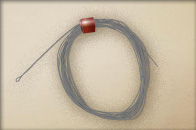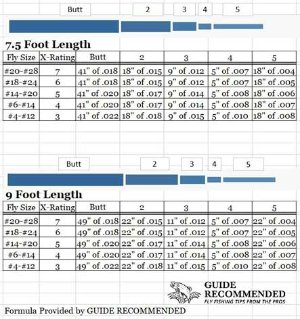Fly Fishing Leaders
Learn more about fly fishing leaders and how to use them more effectively to attract fish. Learn how to select fly fishing leaders. Get fishing tips on using leaders to connect line to fly.
Best Fly Fishing Leaders
Fly fishing leaders have three sections: the butt, midsection and tippet. The first fly line to leader connection is the butt, and in contrast to the tippet, is the thickest piece of monofilament making up the leader. To consistently turn the fly over in casting, midsection fly leaders must be tapered down from the thick, heavy butt to the narrow, thin fly fishing tippet. Tapering throughout the midsection – which takes up nearly half of the total leader length – allows for a smooth transfer of energy from the main line through the leader and tippet to the fly, which is needed for the line to straighten out properly. Leaders may be hand-tied, with smaller diameter leaders between knots, or purchased as a continuous knotless taper from the butt to the fly line tippet.
How To Select Leaders
 The best fly fishing leaders and tippets are those that suit the fishing situation. For example, when you're fishing small flies on flat water for trout or panfish, the fly leader should be small in diameter. The leader must have a relatively soft fly fishing tippet for soft presentation of the fly, and it must be long enough to assure that the fish is not spooked by the line hitting the water during the cast.
The best fly fishing leaders and tippets are those that suit the fishing situation. For example, when you're fishing small flies on flat water for trout or panfish, the fly leader should be small in diameter. The leader must have a relatively soft fly fishing tippet for soft presentation of the fly, and it must be long enough to assure that the fish is not spooked by the line hitting the water during the cast.
Fortunately, leader manufacturers have labeled their products to help you choose the right leader for your fishing. For instance, a bass leader should be relatively short with a stiffer fly fishing tippet to turn over the large flies you will use. Saltwater leaders will not only be stiff from butt to tippet, but also strong and very abrasion-resistant to withstand the large, sharp teeth of saltwater fish and the powerful runs made by those fish. In addition, fly fishing tippet is measured according to an “X” rating system (see below) to aid in angler selection.
In general, the smaller the fly, the smaller the leader diameter at the tippet. Also, the smaller the fly, the flatter the water and the more easily spooked the fish are, the longer and thinner the leader needs to be to fool them. Some spring-creek trout are so finicky that you may have to go lighter, while in saltwater the fly fishing tippet may have a breaking strength of 20 pounds with a shock tippet of 100 pounds tied in.
Leader Length
A standard fly fishing leader for stream trout, bass and panfish is 9 feet. Some leaders may run as long as 22 feet, and spring-creek fly leaders are often 12 feet or longer. Regardless of length, most beginning anglers follow the 60/20/20 formula for constructing the leader as follows:

Formulas provided by Guide Recommended.
Just keep in mind that as the wind rises, casting longer leaders becomes more difficult.
Connecting Fly Line To Leader
Start by connecting the main fly line to the fly leader butt. While the needle nail knot is the most secure of all the leader-line connections, it takes more time to tie and is harder to master than loop to loop connections. Some leader line even comes pre-tied with perfection loops. Don't let the amount of choices overwhelm you. A good fly shop will not only help you choose, but may even set up your line and leader for you.

Image courtesy of Fix.com
KEEP LEARNING

TakeMeFishing x Teen Vogue
Join us on a creative journey as fashion designer Ahmrii Johnson walks us through her collaborative vision and process with Teen Vogue and fashion brand, Rentrayage, to create a special piece.
LEARN MORE

First Catch Center Trailer Gallery
FCC Trailer Photo Gallery
LEARN MORE

How to Tie a Duncan Knot
Learn to tie a Duncan knot by following these five simple steps. Watch our new video.
LEARN MORE


.png?lang=en-US&ext=.png)